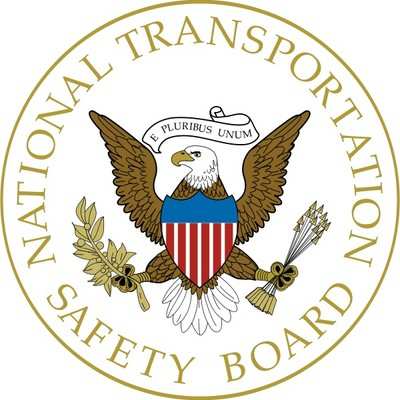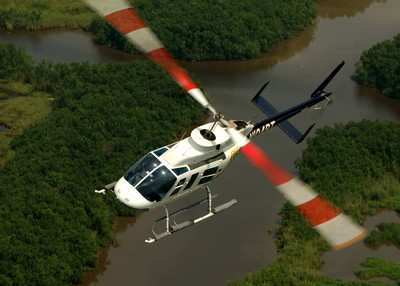The Helicopter Rotated About 180° To The Left And Descended Rapidly In A Nose Low Attitude Until It Went Out Of View
Location: Anaconda, MT Accident Number: WPR24FA132
Date & Time: April 26, 2024, 06:59 Local Registration: N988B
Aircraft: Bell 206-L4 Injuries: 1 Fatal
Flight Conducted Under: Part 137: Agricultural

On April 26, 2024, at 0659 mountain daylight time, a Bell 206-L4, N988B (File Photo Below), was destroyed when it was involved in an accident near Anaconda, Montana. The pilot was fatally injured. The helicopter was operated as a Title 14 Code of Federal Regulations Part 137 aerial application flight.
The pilot had been conducting flights to distribute fertilizer from the same staging location for several days. An employee of the operator, who was performing ground support duties, met the pilot at their base at the Deer Lodge-City-Municipal Airport (38S), Deer Lodge, Montana, about 0545 on the day of the accident. The employee then drove a support vehicle, and the pilot flew to the staging area about 1 mile southeast of Anaconda, Montana. The helicopter was equipped with a bubble window which was installed on the left door. The pilot was operating the helicopter from the left seat position. A spreader was suspended beneath the helicopter utilizing a 25 ft long line attached to a load hook installed on the belly of the helicopter. The load hook could be opened, and the load released inflight by the pilot in the event of an emergency.
Security camera video, taken from cameras located about 0.5 miles north of the staging area, captured the helicopter arriving and landing at the staging area at 0633. The pilot and ground crew member then conducted a safety briefing with a customer representative. According to the representative, the wind was calm during the briefing and remained calm for several hours that morning.
After the briefing the helicopter lifted off at 0643 and maneuvered over the load truck. The helicopter departed the staging area with the first load of fertilizer at 0644, flew to the west and exited the view of the security camera. The helicopter re-entered the camera’s field of view from the west, flew past the south side of the staging area, turned to a northwest heading as it approached the load truck before completing a second onload of fertilizer. The helicopter departed the staging area the second time at 0650, flew out of the field of view to the west, and returned into view from the west at 0656.
The helicopter approached the load truck a third time heading to the northwest, flying a similar approach as before. The helicopter appeared to hover over or near the load truck for 2-3 seconds and then turn and fly away in an easterly direction. The helicopter reapproached the load truck and appeared to complete a third onload of fertilizer. The helicopter then departed and climbed to the west. The helicopter appeared to accelerate and climb out normally to about 200 ft above the ground. About 20 seconds after departing the load truck the helicopter rotated about 180° to the left and descended rapidly in a nose low attitude until it went out of view behind terrain. There are no known witnesses to the accident sequence.
The ground crew member, who was in regular communication with the pilot, attempted to contact him via radio when he did not return when expected, however, received no response. A company representative was conducting other work duties from his truck, which was positioned southwest of the load truck. He also thought it strange that he hadn’t heard the helicopter for a while and drove to a different location behind where he was parked to see the area. During the drive, he saw the helicopter in a nearby gully. He drove back to pick up the ground crew member, responded to the accident site, and initiated an emergency call to 911.
Examination of the accident site revealed that the helicopter came to rest in a mostly upright position immediately adjacent to a flat and dry pond area in a gully about 855 ft southwest of the load truck. The fuselage came to rest oriented a heading of about 060°. The bottom of the fuselage exhibited crushing deformation and the left skid was splayed outward. One main rotor blade was fracture separated about 3 ft from the rotor attachment point just outboard of the blade doubler and the fracture surfaces exhibited downward deformation. The remainder of the blade was located about 15 ft forward of the helicopter. The second rotor blade remained attached to the rotor mast and exhibited some bending opposite of rotation. The spreader and 25 ft long-line were located about 30 ft aft of the helicopter and were not attached to the helicopter, consistent with separation prior to impact. The long-line attachment shackle was unmarred and showed no visible damage. Fuel was observed leaking from the
wreckage following the accident.

The wreckage was recovered to a secure location and examined. All cockpit flight controls were present. The left collective was completely fractured at the elbow. The cyclic yoke was fractured in two places. Both cyclics displayed control continuity to the yoke. The collective levers displayed continuity to the elbow break on the left collective. All control tubes in the control closet displayed fractures consistent with overload. Cyclic and collective control continuity was established (with breaks) to the hydraulic actuators. Tail rotor continuity was established throughout, with breaks consistent with overload.
The engine was displaced vertically within the engine compartment, with all engine mount struts exhibiting varying degrees of damage. All but 2 of the mount struts were found fractured. Cockpit control continuity was not continuous from the collective lever and throttle twist grip through the respective linkages to the power turbine governor and fuel control unit due to impact damage. The pilot throttle was observed in the ground idle position and was immovable. The throttle control linkage, push-pull tubes, and bell cranks in the engine bay were continuous to the fuel control unit (FCU) input control lever. The FCU pointer indicator was positioned at the 0° (OFF).
Clean, clear liquid consistent with Jet A fuel was observed from the airframe fuel filter to the engine fuel pump, FCU, and fuel spray nozzle. The N1 rotor was continuous from the compressor impeller, engine gearbox, starter generator, fuel pump and FCU. Borescope observation confirmed that the gas producer turbine rotor did not turn when the N1 rotor was rotated. The N2 rotor was continuous from the 4th-stage power turbine rotor to the output drive shaft, but an audible rubbing or scrapping sound was heard when it was rotated.
The airframe wreckage and the engine were retained. The engine was prepared for shipment to a facility for further disassembly and examination.
 Aero-News: Quote of the Day (10.23.25)
Aero-News: Quote of the Day (10.23.25) ANN's Daily Aero-Linx (10.23.25)
ANN's Daily Aero-Linx (10.23.25) ANN FAQ: Turn On Post Notifications
ANN FAQ: Turn On Post Notifications Classic Aero-TV: Kitfox Upgrades Back-Country Undercarriage
Classic Aero-TV: Kitfox Upgrades Back-Country Undercarriage Airborne-NextGen 10.21.25: NZ Goes Electric, World Cup UAVs, eAviation Shuttered
Airborne-NextGen 10.21.25: NZ Goes Electric, World Cup UAVs, eAviation Shuttered




